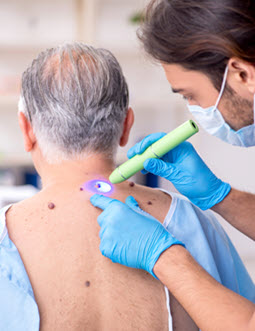Check for the signs of skin cancer to stay proactive about your health.
Check for the signs of skin cancer to stay proactive about your health.
Blog Article
Navigating Skin Cancer Treatment: The Essential Role of Mohs in Modern Dermatology Practices
Skin cancer, an overwhelming medical diagnosis, commonly leaves patients grappling with many treatment options. As we discover the intricacies of this treatment, one will certainly appreciate its essential duty in skin cancer treatment.
Understanding Skin Cancer: Kinds and Threats
Skin cancer, a potentially life-threatening condition, is much more common than many individuals realize. This illness, brought on by the unchecked growth of unusual skin cells, mostly arises from DNA damages as a result of exposure to the sun and ultraviolet (UV) light. There are three primary sorts of skin cancer cells: Basic cell cancer, Squamous cell carcinoma, and Melanoma. While the former two are less deadly and comprise most of identified instances, cancer malignancy is one of the most unsafe. It makes up just concerning 1% of skin cancer cells cases but causes the vast majority of skin cancer cells fatalities - hair loss. Risk elements include fair skin, history of sunburn, extreme sun exposure, living at high elevations or near to the equator, having numerous moles, a family background of skin cancer, and weakened immune system.
What Is Mohs Surgical procedure and How It's Revolutionizing Skin Cancer Therapy
Despite the many therapies currently offered for skin cancer, Mohs surgery attracts attention as a groundbreaking and highly efficient option. Called after Frederic E. Mohs, the doctor that established the treatment, Mohs surgical treatment is a precise surgical technique used to deal with skin cancer. Throughout the treatment, slim layers of cancer-containing skin are gradually gotten rid of and taken a look at till just cancer-free cells continues to be. This strategy enables the specialist to confirm that all cancer cells have actually been removed at the time of surgery. This degree of precision, incorporated with the ability to save as much healthy tissue as feasible, is revolutionizing skin cancer cells treatment. Because of this, Mohs surgical procedure has ended up being a keystone of modern-day dermatology practices.
The Benefits of Mohs Surgery Over Typical Skin Cancer Therapies
Building on the innovative nature of Mohs surgical treatment, it's essential to consider its various advantages over typical skin cancer cells treatments. Unlike standard operating procedures, Mohs provides a higher treatment price, usually getting to 99% for novice therapies and 94% for recurrent cancers. This precision is because of its one-of-a-kind technique of considerably getting rid of and examining tissue layers until only cancer-free cells remain (hair loss). Additionally, it reduces damages to healthy skin, causing less scarring More about the author and improved cosmetic end results. Mohs likewise provides instant results, eliminating the anxiety-ridden delay common with other approaches. It's economical, as the surgical treatment and tiny examination occur simultaneously, removing the requirement for additional research laboratory services. Thus, Mohs represents a substantial development in skin-related techniques.
The Procedure of Mohs Surgical Procedure: What to Expect During the Process

Prospective Adverse Effects and Post-Operative Care of Mohs Surgery
Undergoing Mohs surgery, like any various other operation, includes prospective side impacts that patients should know. Typical negative effects consist of discomfort, wounding, and swelling at the surgical procedure site. These are normally temporary and manageable with non-prescription discomfort medicine and ice packs. In rare situations, individuals may experience infection, bleeding, or a sensitive reaction to the regional anesthetic. Post-operative treatment is critical to recovery and lessening Related Site negative effects. This typically involves maintaining the wound tidy and completely dry, taking prescribed medicines, and avoiding difficult activities. People should also participate in all follow-up visits for wound care and monitoring. In some situations, additional therapies may be necessary to guarantee complete elimination of the cancerous cells. Following these post-operative care standards can significantly enhance recuperation and outcomes.
Final thought

Report this page